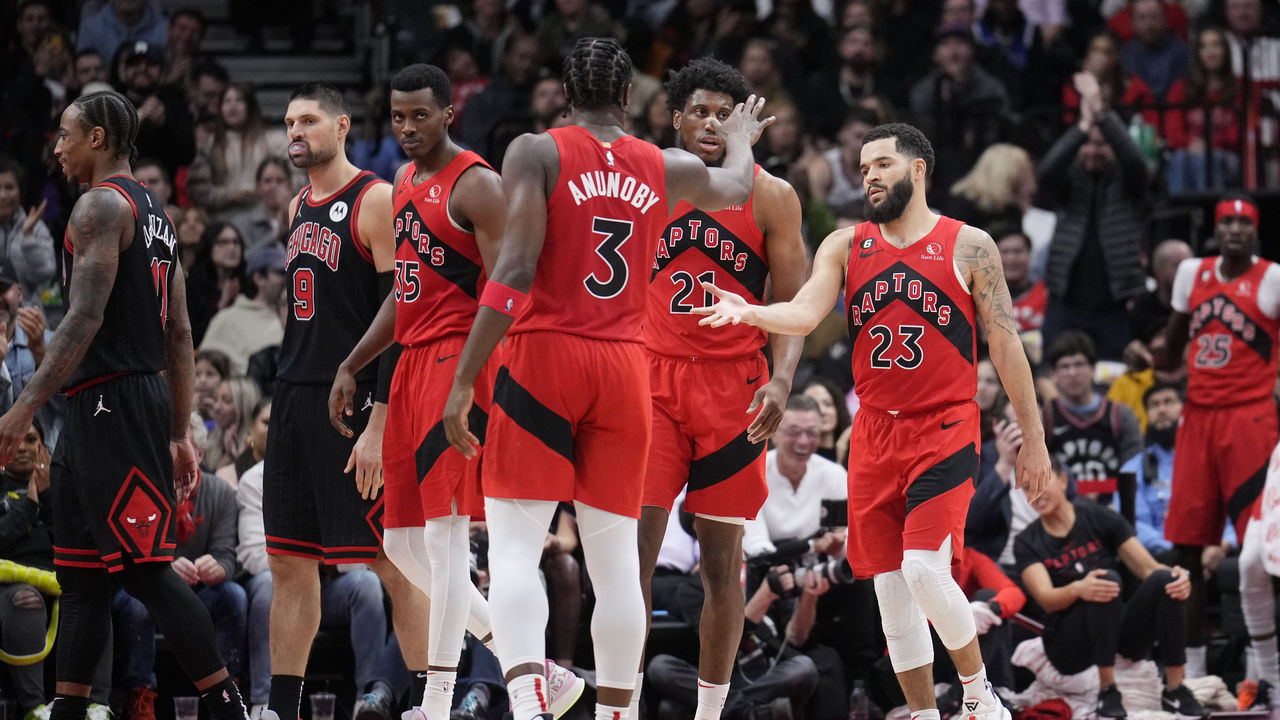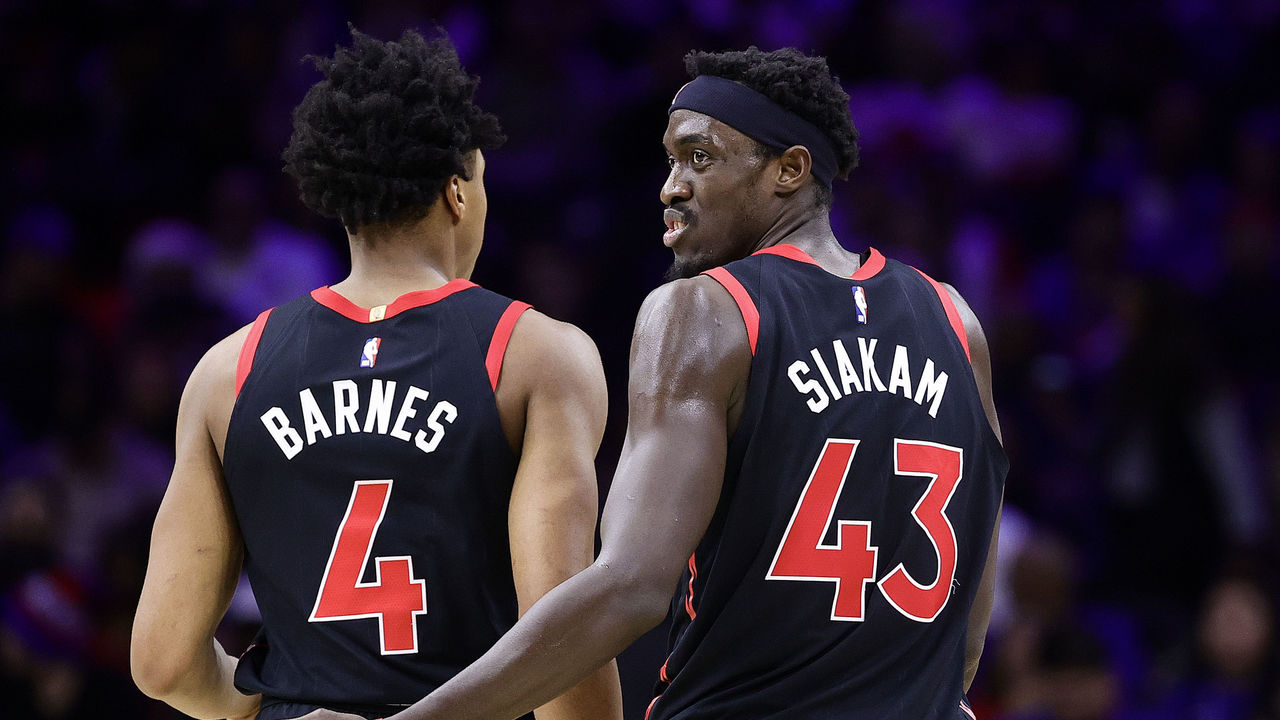The Raptors are at a crossroads. Or are they?
It was never going to be easy for the Toronto Raptors to build on or even sustain their improbable, unconventional success from last season. In the offseason, the front office largely stayed true to the team-building vision that prioritized (and perhaps over-indexed on) length and positional flexibility, which once again left the Raptors light on guards and big men. This is to say, it once again left them light on shooting, off-the-dribble creation, pick-and-roll finishing, and back-line defensive stability.
Masai Ujiri and Bobby Webster weren't necessarily wrong to give the fun, funky 2021-22 group a vote of confidence by running it back. But doing so meant banking entirely on internal development to address their limitations. The margin for error was slim from the outset, and it evaporated completely in short order.
Early-season injuries knocked out key rotation players Precious Achiuwa and Otto Porter (both of whom remain sidelined), further weakening the team's already flimsy depth, rim protection, and 3-point shooting. Toronto's only other bankable long-range shooters (Fred VanVleet and Gary Trent Jr.) have struggled badly with their shots. Reigning Rookie of the Year Scottie Barnes has stagnated or regressed in virtually every area. The bench still lacks offensive punch, forcing Nick Nurse to lean too heavily on his starters again.
There have been three unambiguous success stories from this Raptors season: Pascal Siakam continuing his ascent into rarefied superstar air, O.G. Anunoby cranking up his defensive playmaking to unseen levels while steadily building out his power-based offensive game, and the team following up last year's possession-game dominance by producing an even larger margin (roughly nine more shooting possessions per contest than their opponents). Everyone and everything else has either been wildly up-and-down or flat-out disappointing.
Jump-shooting and advantage creation remain glaring deficiencies. To put some numbers on it: Toronto ranks 27th in 2-point percentage and 29th in 3-point percentage, and it doesn't have a single regular rotation player with a true shooting percentage above 60%. (The Celtics, to use one point of comparison, have seven.) The Raptors lead the league in transition frequency, but they're third from the bottom in first-shot half-court offense. They rank fourth in isolation frequency but 28th in points per iso. They take the sixth-most off-the-dribble jumpers per game, but only the Lakers have a worse effective field-goal percentage on those pull-ups.
At the defensive end, Nurse's help-heavy, ball-pressuring scheme continues to force gobs of turnovers, but the returns are diminishing as opponents deduce how to plan around it. The Raptors' penchant for putting two on the ball and playing shorthanded on the back side, combined with some poor point-of-attack containment and the lack of a true center outside of mistake-prone rookie Christian Koloko, means they don't defend the rim particularly well. They allow the league's 10th-highest frequency of shots inside the restricted area and the third-highest field-goal percentage on those shots, per Cleaning the Glass. Toronto's aggressive help and physicality also allow opponents to dine out on corner threes and free throws.
All told, the Raptors' true shooting percentage (55.2%) ranks 28th in the NBA, while their true shooting percentage allowed (60.2%) ranks 29th. Their possession advantage can only help them make up so much ground. The net result is a 15-18 record that has them hanging onto a play-in spot by a thread. That's a major disappointment for a young team many expected to take a step forward after winning 48 games a season ago.

The situation, however, isn't as dire as it appears. The Raptors have miraculously managed to eke out a positive scoring margin thanks to their ability to control the glass, the turnover game, and the open court. After weathering a six-game losing streak that saw them scrape rock bottom, they picked up a pair of big road wins in New York and Cleveland (the latter improving their record to 3-0 against the Cavs this season).
VanVleet seems to be breaking out of his epic shooting slump, improving his inside-the-arc scoring during the cold stretch. Despite constantly operating in the tightest confines, Siakam looks unflappable and unstoppable. He's dissecting defenses and dictating the pace of every game with calculated precision. The rotation is starting to calcify, with Malachi Flynn finally solidifying a spot while providing a sorely needed ball-handling and shooting lift. The eventual returns of Achiuwa and Porter will help a ton.
Given the extent of the Raptors' aforementioned struggles, it might seem fanciful to think anything other than a dramatic overhaul can radically change their fortunes. However, modest upgrades in the right places would go a long way. It's clear where they need help. Toronto needs a guard who can create his own shot and break a defense down off the bounce. It also needs a center who can protect the rim, execute drop coverage, and connect/finish offensive possessions in a way Koloko can't. Either of those theoretical players would nicely round out a starting five that's relied on stopgaps like Juancho Hernangomez and Thaddeus Young while the rookie takes his lumps.
On top of being tasked with shouldering a huge ball-handling load, VanVleet is also basically the team's primary pick-and-roll screener right now, playing the other end of inverted actions with Siakam, Barnes, and Anunoby. That's an effective setup. Those three can all attack smalls on switches, and VanVleet's a great screener whose shooting needs to be accounted for when he pops or slips out to the 3-point line. But it would be nice to get this group one legitimate roll threat at some point. If Toronto can get another creator who can toggle between running the second unit and playing off-ball alongside the starters, so much the better.
Again, these wouldn't need to be star-level additions to make a major impact. There are a few places the Raptors could turn in search of a package that adequately addresses both needs. Think Jakob Poeltl and Tre Jones from San Antonio, Immanuel Quickley and Isaiah Hartenstein from New York, Jordan Clarkson and Kelly Olynyk from Utah, or, on the lower end, Monte Morris and Daniel Gafford from Washington. Could Toronto get there by dangling Trent (an impending free agent who feels unlikely to be re-signed) along with some form of draft compensation?
Maybe a more pertinent question: Since those would largely be short-term fixes, would the front office deem any of them worth what they would cost in terms of future flexibility? And if Ujiri and Webster don't see enough upside there this season, will they go the other direction and look to be a seller, shifting the Raptors' competitive window a bit further out?

To be clear, that window would still be re-installed in Siakam's corner of the office. The notion of stripping down the present-day roster to build toward a Barnes-centric distant future never made a ton of sense, but it's become even harder to rationalize this campaign. Siakam is playing like a top-10 player, is squarely in his prime, and continues to level up. For most of the season, Barnes hasn't played like someone worthy of being built around or dictating the franchise's direction on his own.
That doesn't mean he won't ultimately become that level of player. But even if this sophomore slump turns out to be a short detour before he climbs back onto his ascendant development track, it's as likely as not that he'll never be as good as Siakam is now. This team's sweet spot is probably the next three to five years, with Barnes ideally entering his prime before Siakam exits his. In that sense, there's a compelling case for Toronto to take a step back this year to raise the ceiling in the near-term future.
Anunoby is very likely part of the long-term core, and the Raptors would have to be bowled over by an offer to consider moving him. But given the reported level of league-wide interest in his services and that he might never have as much trade value as he does right now due to his extremely team-friendly contract, Toronto probably has to at least be open to the possibility. Still, the more realistic core piece to get moved is VanVleet, who, like Trent, is almost certain to opt out of his contract and become a free agent after this season.
VanVleet's still just 28 and an integral part of the team's fabric as a player and culture-setter. However, lower-body injuries have hobbled him, and he's shown some troubling regression this season, not just as a shooter but as a point-of-attack defender. If the Raptors aren't sure they want to pay his next contract, it makes a lot of sense to explore his market now given where the team is at. (By the same token, those struggles might cool his market to the point that it makes more sense to keep him.)
It's also important to note that while a Trent deal could theoretically address some of the Raptors' current needs, there's almost no scenario in which trading VanVleet makes the team better this season. As a steady-handed vet who's about to hit the open market and likely command a new nine-figure deal, he'll have appeal to win-now teams and win-now teams only. None will be offering an equivalent or better player (or package of players) in return. If Toronto's goal in a trade is to balance its existing roster, then it doesn't seem like a good idea to deal away one of the two guys on it who can capably handle the ball and consistently hit threes off the dribble.
The idea behind trading VanVleet would be to accumulate more draft capital and young talent. Not necessarily to develop it but potentially to position the Raptors for a bigger trade down the road - the kind that could pair Siakam with a true lead guard. If that's the direction they decide to take, they'd also surely look to trade Trent for a pick- or prospect-oriented return, possibly even as part of the same deal. It might be tough to sell Siakam on effectively punting this season (especially given what that could mean for his All-NBA candidacy). But he'd probably understand if the club explained that it was giving itself as much ammo as possible to make a run at the next Donovan Mitchell-type star who springs loose.
So, it feels like the Raptors have arrived at a crossroads. They're arguably the team with the most interesting and consequential decisions to make this trade season as they weigh their present and future ambitions against each other. They're also in a position where the answer to which path they should take can plausibly be "both." Despite the frustration that clearly seeped into the players and coaching staff during their recent skid and the angst currently gripping the fan base, the team's still in a great spot in the big picture. They possess a handful of tantalizing 23-and-under talents, cornerstone vets just entering their primes, and all their own first-round picks moving forward.
There are plenty of roads branching out in front of them that could lead to all kinds of exotic destinations. And then there's the option to stay on the one they're on, ride this season out to wherever it leads, and reassess their direction in the summer.
These aren't easy decisions for the Raptors' esteemed brass. As ever, it'll probably be the rest of the league, in the end, that makes those decisions for them.